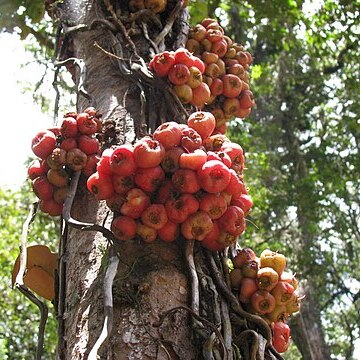Tree up to 20 m tall, dioecious. Leafy twigs 2-6 mm thick, glabrous, hollow; periderm of older parts flaking off. Leaves spirally arranged; lamina elliptic to oblong to (sub)obovate, (7-)10-28 by (3-)5-14 cm, often slightly asymmetric at the base, (sub)coriaceous, apex (shortly) acuminate, base subcuneate to rounded, margin entire; both surfaces glabrous, smooth; cystoliths only beneath; lateral veins (4-)6-10 pairs, basal pair often running ± parallel to the margin up to 1/6-1/4 the length of the lamina, unbranched, other lateral veins often furcate far from the margin, tertiary venation (sub)scalariform; waxy glands indistinct or only one distinct in the axils of the basal lateral veins; petiole 2-9 cm long, glabrous, the epidermis flaking off; stipules 1-2.5 cm long, glabrous, caducous. Figs cauliflorous on clustered stout branched or unbranched leafless branchlets on the trunk; peduncle 1.5-3.5 cm long; basal bracts 3, 2-4 mm long, subverticillate, coriaceous, glabrous; receptacle depressed-globose to subpyriform, 1.5-3.5 by 1.5-4 cm when dry, up to 6 cm diam. when fresh, often up to 1.3 cm long stipitate, glabrous, without lateral bracts, reddish to purplish red at maturity, apex ± concave, ostiole 4-6 mm diam., ± prominent; internal hairs absent.
More
A fig. It is a tree with small buttresses. The bark is thin. The leaves are green on the top surface with white veins and underneath the leaf is light dull green. The leaf is 29 cm long by 12 cm wide. The leaf stalk is 7 cm long. There are 8 to 10 pairs of side veins. The fruit are bright green and turn red. They are pear shaped with small bracts near the base. The fruit are produced on the stem below the leaves on a thick, rough twig. The fruit are 2 cm across.


